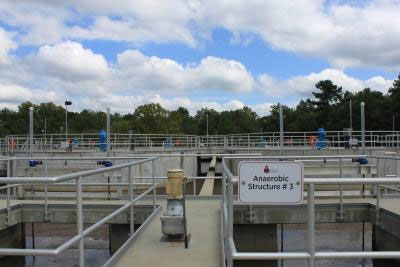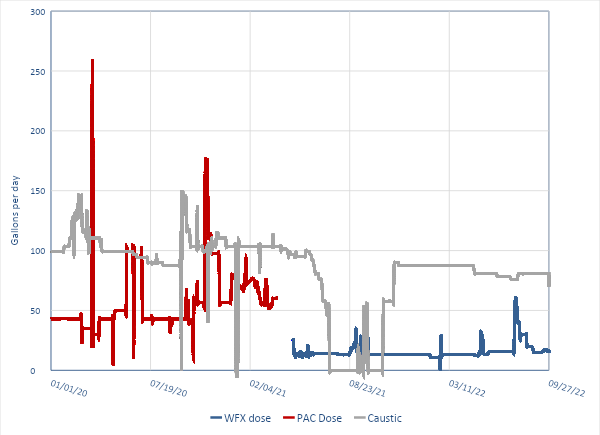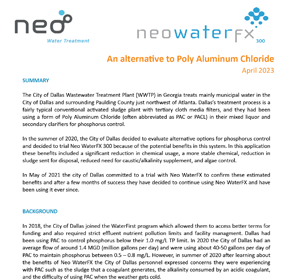April 2023
SUMMARY
The City of Dallas Wastewater Treatment Plant (WWTP) in Georgia treats mainly municipal water in the City of Dallas and surrounding Paulding County just northwest of Atlanta. Dallas’s treatment process is a fairly typical conventional activated sludge plant with tertiary cloth media filters, and they had been using a form of Poly Aluminum Chloride (often abbreviated as PAC or PACL) in their mixed liquor and secondary clarifiers for phosphorus control.
In the summer of 2020, the City of Dallas decided to evaluate alternative options for phosphorus control and decided to trial Neo WaterFX 300 because of the potential benefits in this system. In this application these benefits included a significant reduction in chemical usage, a more stable chemical, reduction in sludge sent for disposal, reduced need for caustic/alkalinity supplement, and algae control.
In May of 2021 the city of Dallas committed to a trial with Neo WaterFX to confirm these estimated benefits and after a few months of success they have decided to continue using Neo WaterFX and have been using it ever since.
Background
In 2018, the City of Dallas joined the WaterFirst program which allowed them to access better terms for funding and also required strict effluent nutrient pollution limits and facility managment. Dallas had been using PAC to control phosphorus below their 1.0 mg/L TP limit. In 2020 the City of Dallas had an average flow of around 1.4 MGD (million gallons per day) and were using about 40-50 gallons per day of PAC to maintain phosphorus between 0.5 – 0.8 mg/L. However, in summer of 2020 after learning about the benefits of Neo WaterFX the City of Dallas personnel expressed concerns they were experiencing with PAC such as the sludge that a coagulant generates, the alkalinity consumed by an acidic coagulant, and the difficulty of using PAC when the weather gets cold.

Figure 1 City of Dallas WWTP
TRIAL OVERVIEW
CHEMICAL P REMOVAL
The WaterFX 300 trial kicked off in May 2021, WaterFX 300 was dosed directly into the aerobic zone and the PAC was suspended at the same time. Over the next few days the system reached a new equilibrium with a steady dose of coagulant and a steady effluent TP concentration around 0.5 mg/L.
| Chemical | Pre-May 2021 | Post May 2021 |
|---|---|---|
| PAC (gpd) | 45-65 | 0 |
| Caustic 50% (gpd) | 101 | 74 |
| WaterFX 300 (gpd) | 0 | 13-18 |
Table 1 Average Chemical Dose
Effluent TP was maintained below their 1.0 mg/L limit during the transition and they were quickly able to scale back their use of caustic to maintain alkalinity, pH, and nitrogen removal within their desired ranges. Figure 2 below shows these chemical usages by day over the course of 2020, 2021, and 2022.

Figure 2 Chemical Dose throughout 2020, 2021, and 2022 with WaterFX 300 and PAC
Table 1 and Figure 2 reveal that the assumptions of reduced chemical consumption were correct. The City of Dallas was able to switch from an average 45-65 gallons per day of PAC to 13-18 gallons per day of WaterFX while achieving the same effluent quality and same phosphorus removal in their system. They were also able to reduce their caustic by about 25% due to the reduced volume of acidic coagulant use but they still require some caustic because their influent alkalinity is insufficient to support their nitrogen removal process.
For the full year after the trial began, a daily dose of about 16 gallons per day of WaterFX 300 replaced about 55 gallons of PAC and 25 gallons of caustic. Focusing on just the cost of these 3 chemicals, change to WaterFX is expected to save the City of Dallas about $10,000 per year at 2023 chemical prices.
SLUDGE REDUCTION
A secondary benefit of reducing coagulant chemical volume is reduced sludge production. Chemical coagulants like ferric chloride, PAC and aluminum sulfate (and WaterFX 300 to be fair) will generate approximately 0.5 lbs. of dry chemical sludge per solution pound of chemical added. When sludge is dewatered to 20% solids this 0.5 lbs. of dry sludge expands to 2.5 lbs. of wet chemical sludge per pound of chemical used. A facility like City of Dallas, using 55 gallons per day of PAC and dewatering to 16% solids, could be making around 1900 lbs., nearly 1 ton, per day of additional wet sludge just from the addition of the PAC. Consequently, they pay for the PAC twice, once to purchase it and again to dispose of the waste it generates. WaterFX 300 reduces this sludge simply by requiring less chemical to accomplish the same result, in this case 3 times less chemical.
Along with WaterFX 300 generating less chemical sludge, the City of Dallas found the benefit of improved dewatering in their screw press after switching from PAC. While using PAC at 55 gallons per day in the weeks before the trial, the belt press cake typically returned around 15.9% solids by weight. After switching to WaterFX 300, the belt press returned a dryer cake, at around 17.1%. This improvement from 15.9% to 17.1% represents an actual decrease of 7.5% reduction of total sludge just due to better dewatering.
The combination of generating less chemical sludge and dewatering to a higher %solids in the screw press directly resulted in fewer tons of biosolids sent to disposal. Since switching to WaterFX 300 the City of Dallas reports that they have measured about a 15% reduction in total sludge sent for disposal. This 15% reduction in sludge works out to nearly $40,000 in annual savings based on disposal prices in 2021.
Additonal Benefits
Since switching to WaterFX 300 in 2021, the City of Dallas WWTP also reports that they have appreciably noticed they are spending less time and money on cleaning algae out from the secondary clarifiers. This is likely due to the way WaterFX 300 binds to phosphorus and makes it unavailable for biological uptake, effectively starving the algae in their clarifiers from the limiting nutrient of phosphorus.
Another benefit that The City of Dallas has reported is that they don’t have to worry about the WaterFX freezing or gelling at low temperatures. Unlike PAC which can thicken and gel at 35°F, WaterFX 300 is stable and pumpable all the way down to -40°F. So WaterFX users in Georgia and even in Wisconsin can store WaterFX in unheated containers and not worry about colder temperatures taking away their ability to remove phosphorus.
Highlights while using WaterFX 300
- TP was kept in total compliance with 13-18 gpd of WaterFX 300 vs 45-65gpd of PAC, which often required much higher than average doses to control upsets.
- The need for caustic addition was reduced by 25%.
- Screw press cake solids increased from about 15.9% to 17.1%
- Total sludge was reduced by about 15% according to the facility.
RESULTS and CONCLUSION
There were multiple financial and operational benefits for the City of Dallas to continue using WaterFX instead of PAC:
- The TP results were maintained below the low permit limit of 1.0 mg/L and lower throughout the trial period while using WaterFX 300 while consistently using 3-4 times less chemical coagulant.
- The financial savings of changing to WaterFX 300 from PAC saved the facility approximately $50,000/year by reducing overall chemical volume and reducing sludge by 15%.
- The facility noticed less algae growth in the clarifiers after switching to WaterFX
- The operators also appreciate not worrying about disruption of chemical feed in lower temperatures.
During the entire trial period there were no reported instances of non-compliance and since that time the plant has been in total compliance with its National Pollutant Discharge Elimination System (NPDES) discharge permit while continuing to use WaterFX 300.
The City of Dallas WWTP is convinced that the WaterFX 300 trial was a success and is continuing to use the WaterFX 300 as their coagulant.



